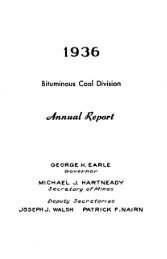Reports of the Inspectors of Mines of the anthracite coal regions of ...
Reports of the Inspectors of Mines of the anthracite coal regions of ...
Reports of the Inspectors of Mines of the anthracite coal regions of ...
You also want an ePaper? Increase the reach of your titles
YUMPU automatically turns print PDFs into web optimized ePapers that Google loves.
:<br />
INSPECTORS OF MINES. 167<br />
<strong>the</strong>y complete <strong>the</strong> sinking <strong>of</strong> <strong>the</strong>ir present shafts and erecting <strong>of</strong> ano<strong>the</strong>r<br />
breaker, which <strong>the</strong>y have in contemplation, near <strong>the</strong> location <strong>of</strong> <strong>the</strong>ir drifts.<br />
This second breaker spoken <strong>of</strong> is intended, so stated, to prepare <strong>the</strong> <strong>coal</strong>s<br />
from <strong>the</strong> Eed Ash seam alone, upon which two <strong>of</strong> <strong>the</strong>se drifts are opened<br />
out. Work is progressing finely in <strong>the</strong>se drifts by driving gangways and<br />
opening chambers ready so as to enable <strong>the</strong>m to mine quite extensively^ as<br />
soon as <strong>the</strong>ir first breaker will be completed, which will be ready early in<br />
<strong>the</strong> spring <strong>of</strong> 1876.<br />
The two shafts above referred to have not yet penetrated <strong>the</strong> <strong>coal</strong>, having<br />
had considerable trouble in passing through <strong>the</strong> surface wash or alluvium <strong>of</strong><br />
about 60 feet. The rock was found at <strong>the</strong> aforementioned depth, which<br />
gives <strong>the</strong>m <strong>the</strong> necessary foundation for <strong>the</strong>ir shaft timber and a good ro<strong>of</strong><br />
for covering for <strong>the</strong>ir <strong>coal</strong> seam. Those shafts are located about 200 feet<br />
apart and sank simultaneously, so that not much delay will be occasioned<br />
in <strong>the</strong> time necessary to make a lawful second opening, <strong>the</strong> distance between<br />
<strong>the</strong>m being so small.<br />
The area <strong>of</strong> <strong>the</strong> mining territory <strong>of</strong> this company is stated to be about<br />
800 acres, and very favorably located for outside arrangements.<br />
Maltby New Circular Shaft.<br />
This shaft, although commenced in 1872, has not been completed up to<br />
<strong>the</strong> present time. I stated in my previous reports that it was a circular<br />
shaft. The shaft lining, being a brick wall 21 inches through, which was<br />
let down by building continuously upon <strong>the</strong> top, its weight pressing it<br />
down as <strong>the</strong> sand and o<strong>the</strong>r material was taken out. The wall finally became<br />
so bound bj' timber pressing upon its sides that its strength was not<br />
sufficient to resist <strong>the</strong> unequal pressure upon its outside, and its cast-iron<br />
plates having broken work was discontinued for some time. During this<br />
summer Mr. A. 0. Fowler, <strong>the</strong> superintendent, has changed <strong>the</strong> plan, and<br />
has had a cast-iron tube cast in whole rings in sections <strong>of</strong> about 4 feet in<br />
length, and has succeeded in putting <strong>the</strong> same inside <strong>of</strong> <strong>the</strong> brick wall and<br />
reached a depth <strong>of</strong> about 100 feet, or about 20 feet below <strong>the</strong> brick wall.<br />
A short distance below <strong>the</strong> brick wall <strong>the</strong>y struck a bed <strong>of</strong> clay, perfectly<br />
dry ; but this did not last long before <strong>the</strong>y were surprised and driven righc<br />
out by a force or pressure from below, driving <strong>the</strong> sand, clay and water up<br />
through <strong>the</strong> bottom until <strong>the</strong>y had to adopt still ano<strong>the</strong>r new apparatus<br />
called a digger, a kind <strong>of</strong> an automatic shovel, which acts exceedingly<br />
well so far as tried, as by this means <strong>the</strong>y are enabled to draw up <strong>the</strong> sand<br />
and clay without taking out <strong>the</strong> water and <strong>the</strong> great weight <strong>of</strong> <strong>the</strong> cast-iron<br />
tubing, pressing it down many feet below <strong>the</strong> excavated part, <strong>the</strong>reby<br />
forming a leader or shoe. It is thought that matters looks more favorable<br />
now than at any o<strong>the</strong>r time from its commencement to reach <strong>the</strong> solid<br />
rock, which is at a distance <strong>of</strong> about 40 feet below <strong>the</strong>ir present tubing.<br />
Second Openings.<br />
The following mines have had <strong>the</strong>ir second openings completed this year,<br />
to wit<br />
J. H. Swoyer's For'ty Fort Colliery.—This mine has had a small shaft, 50<br />
feet deep, sank from an overlying seam, which is intended to be used as a<br />
second opening for this mine, and also to be used for ventilating purposes,<br />
and eventually be enlarged and afterwards used for a hoisting shaft for <strong>the</strong><br />
<strong>coal</strong>s from <strong>the</strong>ir present seam, while that <strong>the</strong> present main or hoisting shaft<br />
will be continued down to an underlying seam, &c.




![1945 Anthracite Annual Report Districts 19 - 25 [Adobe pdf - 9148Kb]](https://img.yumpu.com/50308099/1/190x119/1945-anthracite-annual-report-districts-19-25-adobe-pdf-9148kb.jpg?quality=85)


![1937 Anthracite Annual Report Districts 1 - 11 [Adobe pdf - 9394Kb]](https://img.yumpu.com/43539962/1/190x119/1937-anthracite-annual-report-districts-1-11-adobe-pdf-9394kb.jpg?quality=85)







![1931 Anthracite Annual Report Districts 1 - 11 [Adobe pdf - 8007Kb]](https://img.yumpu.com/39427789/1/190x119/1931-anthracite-annual-report-districts-1-11-adobe-pdf-8007kb.jpg?quality=85)

